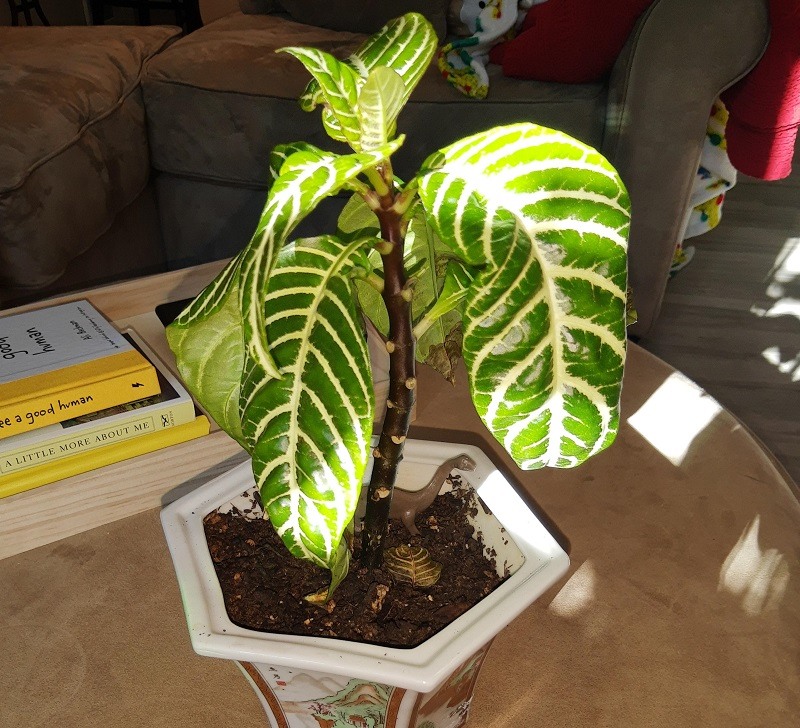I love seeing zebra plants on my desk. The bold striped leaves mark a lasting impression. But within the past two weeks, I notice my zebra plant leaves turning yellow. It took me three days to identify the exact causes and fixing techniques.
So, why are my zebra plant leaves turning yellow? Zebra plant leaves turn yellow due to inappropriate watering routines and lack of sunlight. Other possible causes are low humidity, nutritional deficiency, pests, and diseases.
Take the time to read through this zebra plant turning yellow article to revive your houseplant. I have also shared my experiences and tips for fixing yellow zebra plant leaves. Be sure to read through the zebra plant-related questions.
You May Also Like: How to Care for Calathea Mokayana (Peacock Plant)

Reasons for Zebra Plant Leaves Turning Yellow
Overwatering Problem
Yellow leaves on zebra plants are a classic sign of overwatering. The tropical plant loves a slightly moist potting medium to thrive well.
A damp environment will also damage the roots which inhibit water uptake. A drought-like situation will also result in yellow leaves that then turn brown.
Find the appropriate watering balance to avoid overwatering issues. The golden rule is to inspect the potting soil moisture before watering the plant.
Ensure the potting soil is well-aerated and can drain excess water. Reduce watering frequency during winter due to slow-growth rate.
Incorrect Lighting
Zebra plants are sensitive to sudden light changes. Low-light or direct sunlight exposure can cause yellow leaves on zebra plants.
The tropical plant prefers eight hours of bright indirect sunlight. Low light conditions will make the houseplant lose the zebra-like patterns.
Put the zebra plant near the south or west-facing window with sheers and curtains. These sheers help to protect the plant from the direct sun.
Inconsistent Watering Habits
Zebra plants do best in relatively moist soil. The soil condition helps keep the houseplant hydrated and healthy throughout the year.
Dry soil tends to stress the tropical plant and cause leaves to turn yellow. The drought condition makes the plant dehydrated and deteriorates the leaves’ structure.
Soak the potting soil until the excess water runs through the drainage holes. Keep monitoring the soil moisture more often to revive the tropical plant.
Pest and Diseases
Zebra plants are more vulnerable to spider mites, mealybugs, and scales. These sap-sucking creatures cause yellow and stunted foliages.
Use neem oil or insecticidal spray to eradicate the pests on the leaves. Place the houseplant in a well-ventilated room receiving bright indirect sunlight.
Fusarium is a common fungal disease that attacks zebra plants. It causes yellowing and wilting of the leaves. It also makes the stem veins turn brown. Use copper fungicide as a treatment.
Low Humidity
Zebra plants like high humidity to stay happy and healthy. They may tolerate low humidity, but the stress will cause yellowing leaves.
Ensure the indoor humidity is above 50% to foster the best appearance. Use a digital hygrometer to monitor the indoor humidity changes.
Use an electric humidifier to increase humidity around the houseplant. Another excellent option is to mist the plant since it makes a big difference.
Acclimation
A sudden environmental change could be the reason behind zebra plant leaves turning yellow. The condition at the plant store is different from that at home.
If your zebra plant leaves turn yellow after bringing at home, it will take a couple of weeks to adjust and restore the striking zebra-like patterns.
Extreme Temperatures
Zebra plants prefer a temperature range of 60-80oF. These tropical houseplants cannot tolerate freezing temperatures. A sudden dip in temperature can cause yellow leaves.
Keep the zebra plant away from heaters, radiators, air vents, and windowsills. These cold and hot drafts can be responsible for the yellowing of leaves.
Fertilization Issues
Zebra plants are not heavy feeders when compared to other tropical houseplants. But fertilizer nutrients help to foster vegetative growth.
Over-fertilization can cause yellow and brown leaves, among other issues. But under-nutrition is the main reason behind the yellow or pale foliages.
Use a dilute balanced fertilizer to feed your houseplant. The fertilizer nutrients will help to combat zebra plant yellow leaves.
Transplant Shock
Re-potting can be hard on zebra plants. Besides that, these tropical houseplants are less vulnerable to root-bound issues.
I recommend re-potting if the soil fertility is exhausted. It will take time to acclimate to the fresh potting soil. Yellow leaves will occur to mark the end of acclimation.
Natural Aging Process
Most plants lose their lower leaves due to the natural aging process. A mature leaf deteriorating due to age will never recover regardless of providing ultimate care.
Trim the old leaves with a sterilized pruner to redirect energy to growing areas. These old foliages are usually yellow. There is no need to raise alarm over the yellowing of leaves.
You May Also Enjoy:
Related Questions
Why Are My Zebra Plant Leaves Turning Brown?
Inappropriate watering routine and overfeeding are the main cause of zebra plant leaves turning brown. Other causes are direct sunlight exposure and low humidity.
Why Are My Zebra Plant Leaves Curling?
Under-watering and pest infestations are the possible causes of zebra plant leaves curling. Other potential causes are overwatering, plant diseases, drafts, and low humidity.
Why Is My Zebra Plant Turning Yellow?
Zebra plants turning yellow is due to transplant shock, acclimation, inappropriate watering, extreme temperatures, and fungal leaf spot disease.
Final Thoughts
Zebra plants are stunning tropical houseplants with zebra-like patterns foliages. The houseplant is a little bit grouchy when the indoor conditions are harsh.
Yellow leaves on the zebra plant are signs of discontent. The golden rule is to inspect the houseplant and identify the exact cause before fixing it.
I hope the information in this article will help you handle the yellow leaves on your zebra plant with ease. Feel free to share with other houseplant enthusiasts in your community.
